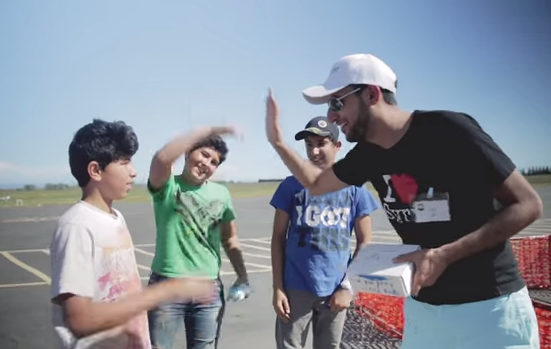How the Syria Airlift Project is Using Open Source Dronecode for Humanitarian Aid

On March 28-29, 2015, Uplift Aeronautics trained a group of Arab-Americans–including refugees from the conflicts in Iraq and Syria–to operate a fleet of four Waliid UAVs for medical deliveries to inaccessible populations. Families took part in every activity, from packing cargo and making parachutes to running preflight checklists and operating ground stations.
Mark Jacobsen is the founder and Executive Director of Uplift Aeronautics.
In March of 2014 I found myself on the Turkish-Syrian border, doing research among Syrian refugees. The stories I heard were horrific. Mass sieges were in effect; the Syrian government and brutal militias were starving out entire neighborhoods, and the government appeared to be deliberately targeting hospitals and doctors. Smuggling medical supplies into opposition-held areas was punishable by torture and death. Syrians were besides themselves, trying to find some way to get food and medicine into these besieged areas. They asked me why the US did nothing.
As a US Air Force C-17 cargo pilot, this is something I know about. The stark reality is that manned cargo airplanes cannot enter contested airspace without being shot down. After hearing these stories, that wasn’t good enough for me. I thought: surely in the 21st century, there must be some way to get at least some aid through. It seemed that micro-UAVs and swarming technology might hold the key. No single airplane could carry much, but if a launch crew could dispatch a plane every five minutes carrying 2 kilograms, that would be 192 kg (420 pounds) per night… per launch crew. The planes would be small, cheap, quiet, difficult to detect, and inefficient to shoot down.
We formed a group called the Syria Airlift Project to develop and implement the concept. Later, this grew into a broader nonprofit corporation called Uplift Aeronautics with a mission to “empower and aid communities through innovative aviation technology.” We currently have the ability to deliver 1 kg packages at a range of 30 kilometers and then return, and are working on a larger plane capable of delivering 2 kg packages at a range of 50 km, which is enough to reach Aleppo from Turkey. We would launch and recovery from Turkey and airdrop via parachute inside Syria, to recipients identified by experienced medical NGOs.
Our airlift paradigm is labor intensive, which is why we looked to nonviolent, mass-participation campaigns like Gandhi’s homespun cloth effort. More than 3 million Syrian refugees are scattered throughout neighboring countries. Many can’t work and are suffering from the boredom and humiliation of unemployment. After four years of barbaric war with no end in sight, they have little hope and their spirits are broken. With the Syria Airlift Project, we could give them something to believe in and give them direct roles in bringing healing back to their country.
The security challenges of a project like this are extraordinary, which is why we turned to Dronecode technology. In a nutshell, we need to make our planes very easy for the good guys to operate and very hard for everyone else. With open-source software like APM:Plane, we could build custom security features right into our firmware. Our custom firmware recognizes when planes are entering Syria and arms custom failsafes. If a plane thinks a crash inside Syria is imminent, it triggers a mechanism that physically damages the autopilot, ensuring it can’t be reused by malicious actors. We are also working on hard-coding no-fly zones around major airports, looking at the use of cryptographic keys and other security features to control access, and experimenting with the 3DR Pixhawk and APM:Plane advanced navigation solutions to ensure continued operation in GPS denied environments.
If the open source technology is valuable to us, Dronecode’s open source community is even more valuable. We built Uplift Aeronautics as a nonprofit because we want to leverage the incredible talent in the developer and maker communities for humanitarian good. We enjoyed meeting much of this community at the Embedded Linux/Dronecode conference in March 2015, and are finding no shortage of help.
This is an extremely ambitious project with immense technological, political, and legal challenges, but we are committed to carrying forward in a safe, responsible, and legal way. Our ultimate goal is to make sieges impossible, and to help shape a world where starvation and medical deprivation are no longer effective as weapons. UAV technology opens up new frontiers for delivering humanitarian aid, and the open-source Dronecode community is uniquely positioned to create solutions.
Written by Mark Jacobsen and originally published on Linux.com



